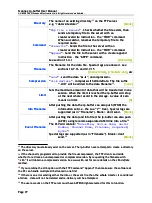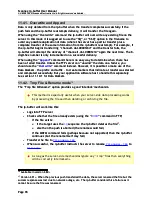
Scannex ip.buffer User Manual
© UK 2007-2021 Scannex Electronics Ltd. All rights reserved worldwide.
10.7.17. Pass-through
The pass-through connection is limited to read-only when collecting from UDP or FTP..
TCP Port
The TCP/IP port that will listen for an incoming connection, or
active connect, for pass-through.
0
= disable pass-through on this channel.
[0]
Connect
“
Device to ip.buffer (passive/server) [Default]
” –
The ip.buffer behaves as a TCP server.
“
ip.buffer to Device (active/client)
” – The ip.buffer
behaves as a TCP client and connects to the remote end.
[Device to ip.buffer (passive/server)]
Interface
“
LAN only
” – dial-in PPP connections are blocked
“
Modem only
” – Ethernet connections are blocked
“
LAN or Modem
” – either PPP or Ethernet can be used
[LAN only]
Address
Enter a name or IP address to connect to (when using
“
ip.buffer to Device (active/client)
” connect
mode)
[blank]
Allow
“blank” will allow any client to connect to the ip.buffer for
passthrough on this channel.
Enter a name, IP address or wildcarded IP address to restrict
inbound access to only that LAN address
. You can also
enter a list of addresses.
[blank]
TLS/SSL
“
No encryption
” – a plain TCP/IP session
“
Implicit (by port)
” – starts with an SSL/TLS connection. A
client that connects with plain TCP/IP will time out and
be disconnected.
[No encryption]
43
When dialling in with a modem the “Allow” address is ignored.
Page 88
Scannex ip.buffer User Manual
© UK 2007-2021 Scannex Electronics Ltd. All rights reserved worldwide.
10.7.17. Pass-through
The pass-through connection is limited to read-only when collecting from UDP or FTP..
TCP Port
The TCP/IP port that will listen for an incoming connection, or
active connect, for pass-through.
0
= disable pass-through on this channel.
[0]
Connect
“
Device to ip.buffer (passive/server) [Default]
” –
The ip.buffer behaves as a TCP server.
“
ip.buffer to Device (active/client)
” – The ip.buffer
behaves as a TCP client and connects to the remote end.
[Device to ip.buffer (passive/server)]
Interface
“
LAN only
” – dial-in PPP connections are blocked
“
Modem only
” – Ethernet connections are blocked
“
LAN or Modem
” – either PPP or Ethernet can be used
[LAN only]
Address
Enter a name or IP address to connect to (when using
“
ip.buffer to Device (active/client)
” connect
mode)
[blank]
Allow
“blank” will allow any client to connect to the ip.buffer for
passthrough on this channel.
Enter a name, IP address or wildcarded IP address to restrict
inbound access to only that LAN address
. You can also
enter a list of addresses.
[blank]
TLS/SSL
“
No encryption
” – a plain TCP/IP session
“
Implicit (by port)
” – starts with an SSL/TLS connection. A
client that connects with plain TCP/IP will time out and
be disconnected.
[No encryption]
43
When dialling in with a modem the “Allow” address is ignored.
Page 88






























